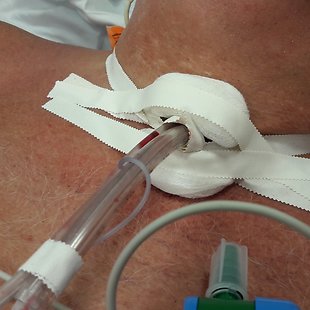Difficult Airway Management - 2020
Difficul airway management (DAM) is a life threatening situation, in which anaesthetist experiences difficulty with ventilation by face mask, supraglottic airway or endotracheal intubation. This can be partially avoided by difficult airway assessment (LEMON score, difficult intubation in the past), however, difficult airway can occur in any patient. Difficulty with airway management may result in serious consequences (hypoxic brain injury, death) in a matter of minutes, therefore one needs to recognize the situation early and proceed quickly.
Review
This interactive algorithm provides a complex description of unexpected difficult airway management, including a possibility of the oesophagus intubation and its recognition. The airway management via nasopharyngeal or oropharyngeal airway, supraglottic airway device or intubation assisted by bougie or stylet is portrayed along with the BACT procedure in case of failure of said methods. All of the abovementioned methods are accompanied by descriptive instructional videos.
The very nature of the step-by-step case study – though very well-constructed – somehow prevents the clear depiction of the urgency of such state, as well as the time constriction that accompanies every difficult airway management case. Choosing fast and energetic approach and the application of strict guideline is vital in cases of can’t ventilate/can’t intubate situations → laryngeal mask, when failed → coniotomy/ BACT.
The video of the BACT procedure shows one of the possible ways to perform this procedure, with a scalpel held in the cut, used as a stylet. This method is originally shown in a very unfortunate video on Difficult Airway Society webpage. Leaving the scalpel in the cut and changing hands while holding the scalpel in place can lead to the injury of posterior part of the trachea wall – pars membranacea – as well as to unnecessary delay. An alternative method is shown in the attached video, where the visual loss of the cut is prevented by fixating skin and tissue layer with fingers held in “V” shape. The tube is then railroaded over the inserted bougie, with rotating motion that is crucial for an easy
insertion of the tube into the trachea. Tube of 6,5mm size is preferred because it allows the subsequent performance of the bronchoscopic toileting .
This method is derived from experience with more than 1000 BACT procedures performed on cadavers and three patients I saved personally using this method.
Sources
ČERNÝ, Vladimír, Jozef KLUČKA, Pavel MICHÁLEK, Michal OTÁHAL a Petr ŠTOURAČ. Doporučený postup ČSARIM “Zajištění obtížných dýchacích cest u dospělých a dětí“ [online]. In: . s. 23 [cit. 2020-04-07]. Available at: https://www.csarim.cz/content/uploads/2019/06/dp_csarim_difficult_airways_final_s_prilohy_180619-2.pdf





